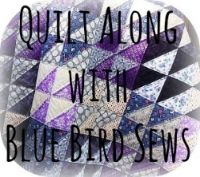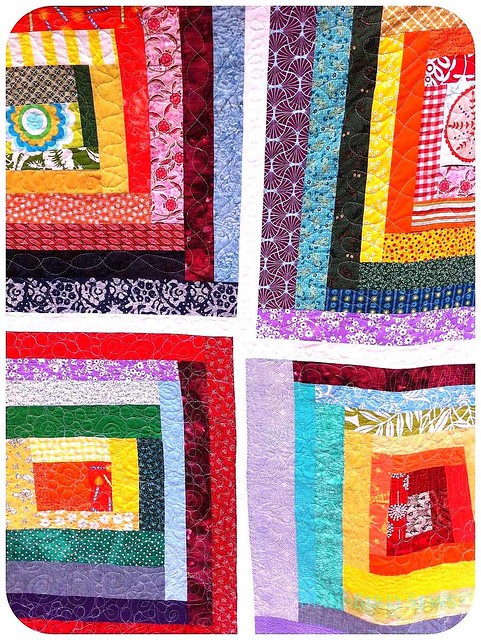Hello Lovelies! Welcome to Week 1 of our Quilt Along! This is the time to choose fabrics and get a plan going for this half square triangle quilt. Hopefully I will come up with a better name than that by the end of the QAL - any suggestions?!
I'm not one for much chit-chat; so let's talk fabric. When I started this quilt I had only 1 request and that was for color - purple and grey to match the soon to be here baby girl room. So I hit up my fabric stash and came out with a stack of all I had in purple and grey - it really wasn't much. Which is a good thing! Limits foster creativity. Without the perfect fabrics I had to get creative and use what I had.
Now I had a stack of fabric in purple and grey but what I look for when auditioning fabrics for a quilt is: Value, Scale and Prints. Three super important factors for getting just the right mix of prints, solids and colors. But before you dig through your stash of fabrics or drive to the fabric store let's talk.
Let's start with value. A really great tool for choosing the right value is to take a picture and change it to black a white. I did that for the next examples and I hope it helps to illustrate the point.
You might notice on the first quilt that there are prints that don't really read purple but the value is there in one way or another. Like the white background and little purple violets. It's not super purpley but it reads as a light value something that you will need to balance out the dark and medium values of the other fabrics.
Notice in the picture above that the fabrics you might have thought were dark - like the grey is actually medium - and the prints you thought were medium are actually dark - like the purple geometric. Know the value of the fabrics will help you match them up with each other and create the most contrast for the HST blocks.
Next there is scale; a good quilt has a place to rest the eyes and a place to move the eye around. So when choosing prints make sure to get a good ratio of tiny prints to keep the eye moving and larger scale prints to give the design a little rest. There is no magic number for how many large scale vs. small scale prints to include - that is up to the designer but let me say 80/20 would not be so great.
Okay, so now go over to your stash and pick a big ol' stack of fabrics in your choice of
color. Red, blue, purple, yellow, green. What ever color you like pick out prints and solids, choose different values, choose your best and least favorites. Then let's mix in a
neutral. In this case the choice was made for me; grey with purple. But you could do; red and grey, blue and grey, green and black, pink and brown, red and brown, blue and tan, yellow and grey, red and black, red and brown, blue and grey, green and black....you get it right? Pick a color and then add a complimentary neutral to it. Now go back to that fabric stash and pull out all prints and solids in your color and neutral choice.
Here's where the colors in the prints come into play. Make sure your prints do not have lots of other colors in them. You want your fabrics to be purple, not purple with lots of yellow - or purple background with big yellow and blue flowers. Make sure your fabrics have just one color in them or a small bit of other colors that keep with either the warm or cool sides of the color wheel depending on the color you have chosen. For example if you color is blue and you have a print with a little bit of green in it then I'd say go for it, but if you have a blue with a little bit of orange then I'd pass. Stick with your color wheel friends.
Let me stress here that the print isn't as important as the
value at this point. Especially for scrappy quilts. The blue hue quilt I made has some of my least favorite fabrics from my stash but it works so well because they are all in the same hue - the value is what gives the interest not the individual prints.
One last addition to your fabric pull is a shade of white. For the quilt above I choose a cream color to break things up a bit. You might want a brighter white or even a beige - that will depend on your color choice and the values in your fabrics. Try a couple out and see what meshes best with your color choice.
Now take all the chosen fabrics and mash that pile together and take a picture of it. Now take that picture and change it to black and white. Got it, okay. That's the picture you want to study for choosing your final set to fabrics to use. Get a good mix of dark, light and medium values.
Here it doesn't matter what colors they are, value is what is important, but you also want a good mix of
color to neutral like around 50/50. For the overall
values I would say 30/30/40 ratio of dark/light/medium so that when putting together blocks you have enough mix to get a good contrast to each block. Here's a picture of my final fabric stack. Looks a lot like the first but I had to edit a bit because I used up a bunch in the last quilt!
Whew! Okay what have you got? A huge wonderful stack of awesomeness - that's what! So here's the part I am not so great at but I'm going to give it a go just for you!
Yardage Required:
Backing: 1 3/4 yard
Binding: 1/2 yard
Light value: 1 yard
Dark value: 1 yard
Medium value: 1 1/4 yard
Now the fabric for the quilt top is an over estimate and because we are working from the stash you probably pulled out way more fabric than this even, that's cool. We'll just cut what we need and re-stash the rest. If you are buying fabric for the quilt then stick with fat quarters or 1/2 yard cuts. For my fabric choices I have about 15 different fabric choices. But I like a scrappy quilt! Chose how ever many you are comfortable with!
Okay now you've got a pretty stack of fabric to pet and talk nice to until we cut it up into squares, okay.
Let me know if you've got any questions. I will respond in the comments below so everyone can benefit from the discussion. And let us know if you have any tips or tricks for picking out your fabrics!
Next time we will talk about cutting and sewing Half Square Triangles and little bit about on-point settings! If you are following along grab a button below!
Cheers!
Kelly















































